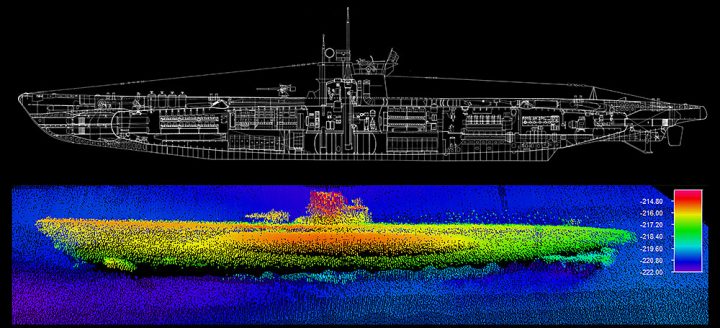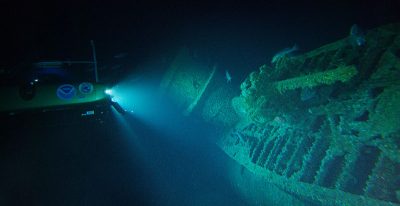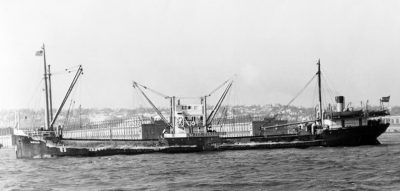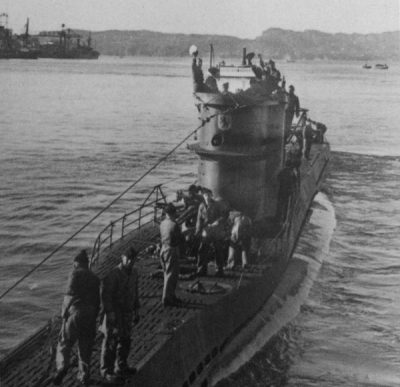
OCRACOKE – Lights out, darkness settling in, Robert Carmichael’s eyes adjusted to the site before him at the bottom of the Atlantic Ocean.
The German submarine U-576 was laying on its side about 700 feet below the water’s surface where it sank in 1942 after being pummeled by depth charges dropped by U.S. Navy air crews and a hail of gunfire from nearby convoy ships.
Supporter Spotlight
Congregated at the U-boat’s tower, a crowd of snowy grouper curiously peered through the sphere of Carmichael’s submersible – a scene he describes as “very cool, very calm.”
“It was very peaceful,” he said, recalling one of a series of dives he made during an expedition last August about 35 miles off the coast of Cape Hatteras.

For 10 days, researchers with the National Oceanic and Atmospheric Administration, or NOAA, and members of Project Baseline, a nonprofit conservation organization supporting the expedition, uncovered secrets buried beneath the sea 74 years earlier.
The information will be included in a documentary about the Battle of the Atlantic, the longest contiguous battle of World War II.
July 15 will mark the 75th anniversary of the sinking of U-576 and its target, the Nicaraguan-flagged SS Bluefields.
Supporter Spotlight
Carmichael, CEO of Brownie’s Global Logistics and operator of GlobalSubDive out of Pompano Beach, Florida, had hoped to return to the site with researchers during the anniversary and continue investigating the underwater battlefield. But, it’s more likely to be 2018 before that may happen.
NOAA funded a portion of last year’s expedition. The money isn’t there this year, and President Trump’s proposed budget aims to slash upwards of $1.5 billion from the Commerce Department, a large chunk of it from NOAA.

Meanwhile, NOAA officials are planning to return to the site later this year, when they’ll deploy an unmanned submarine to conduct further research, according to Joe Hoyt, a NOAA maritime archeologist.
He was inside the submersible Carmichael piloted last year when they got their first look at U-576.
It was the first time that human eyes witnessed the resting place of the German submarine since its demise in 1942, eight months after America entered the war following the Japanese attack on Pearl Harbor.
The U-boat rests a little more than 650 feet from the Bluefields, one of 19 merchant ships being escorted from Hampton Roads, Virginia, to Key West, Florida.
A tractor trailer-size hole left by the torpedo U-576’s crew fired is clearly visible in ship. All 24 of the Bluefields’ crew survived the attack.
NOAA researchers had been looking for the wreckage for seven years when they discovered, using sonar, the two vessels in 2014.
Now that they had the location locked in, they eagerly awaited an expedition that would, they hoped, answer a series of questions about the submarine and its crew.
That time came near the end of last August, when Hoyt and Carmichael confirmed the fate of the 45 German sailors manning the U-boat.
The hatches remain sealed. The crew, all of whom were under the age of 30, had been entombed.
“It was a very sobering moment,” said Hoyt, chief investigator on the site.
Hoyt said NOAA’s next trip to the site is scheduled for late August, early September, when researchers will spend anywhere from 10 to 12 days using sonar to map out the underwater battleground’s debris field.

“We’re going to be out doing a follow-up survey with an AUV,” an autonomous underwater vehicle, which is a small, unmanned system, he said. “We will be doing some follow-up survey on the 576. This will also be a little wider area that we’ll be looking at.”
He said it’s too soon to tell when and whether NOAA will be able to provide funding to support a diving expedition with Project Baseline.
“It depends of a number of factors,” Hoyt said. “We can contribute on the scientific side and the monitoring side. If we have grant money we can bring it to the table.”
In the meantime, Carmichael said the nonprofit has been crafting ways to raise money so that it can continue its pursuit to tell this portion of the story of the Battle of the Atlantic.
“It’s a fairly expensive endeavor to bring a ship and 24 people up from Florida,” he said. “It’s roughly about $30,000 a day when we’re operating with a full crew.”
Through the solicitation of private and corporate sponsors, Carmichael said the hope is to continue filming and researching. One idea being tossed around is offering a major sponsor a seat on one of the submarines to see the wreckage firsthand.
“We look forward to getting back up there,” Carmichael said. “We feel like there’s a need to continue the investigation. We believe there’s an important story to tell.”







